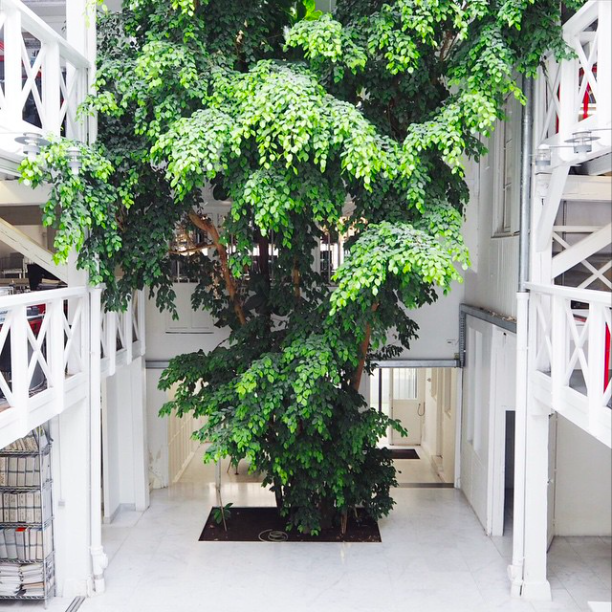Yesterday’s architectural tour of the outskirts of Paris left us with many questions about the mode of architectural practice in this city. First we enjoyed a long breakfast-cum-brunch at the opulent hotel buffet to prepare for a day of practice visits. We hoped to find answers. How did the 1980s building boom get so crazy? How does social housing really work in Paris? How does carrying a baguette make you look so damn cool?
Our first stop was AS.Architecture-Studio. All our questions melted away as we were seduced by the stunning renovation to the rear garden of a Parisian mansion. Behind a docile Haussmann elevation, an indoor tree sprouts from white marble floors, climbing up the traditional white timber framing, amongst staff sitting all around on three floors of mezzanine, to the glass roof above. Deeper into the office and across a courtyard we find a modern extension to the office, matching with tree, glass roof and mezzanine, differing through the use of steel and vinyl instead of timber. Deeper still and we are toured through the practice’s extensive history, displayed in model format in a brick vaulted basement. The stunning offices beside, the work of this international practice inspired questions of Paris’s historic values, over that of a blank canvas like China. Does a practice need to just divert its workflow towards foreign projects in order to get the freedom to design their ideal buildings? We left with no doubt of the quality and innovation of this practice and admired their ability to retain these values at the largest scale of architecture.

Upon departing AS.Architecture-Studio we treated ourselves to a short walk around the historic Marais district. Our first discovery, although not confirmed, seemed to be a perfect candidate for the role of prequel to New York’s Highline park. This elevated Parisian garden gave a new outlook on the surrounding buildings. The lushly gardened strip of about 4.5 km was frequented by runners and locals, and was a great insight into the city’s productive use of disused infrastructure. It also provided an idealistic backdrop for some Instagram-worthy group photos.
Further into the Marais and we picnicked at the Place des Vosges. The first planned square in Paris (and apparently Europe), the 140 m x 140 m grand square was bustling with locals. With our three-course breakfast still digesting, we tucked into some fresh baguettes. Eating and relaxing all day – how very French! The Place des Vosges was a refreshing change from modern and post modern architecture overload. Built in 1612, it is a classic example of Royalist architecture, but still seems very relevant to the city, and to place making. Hundreds of picnickers are testament to its urban success.
Our second practice visit for the day was to the offices of Manuelle Gautrand, where we were treated to a showing of her work, and an engaging discussion spawned on by our fore-mentioned questions. Manuelle told us about the 50s housing boom, the onslaught of “contemporary” tower and slab housing, and how it has forever jaded the French public against any and all new or contemporary architecture. She revealed the Parisian elite’s preference for inner city historic housing, and as result the amount of architectural work focussing on private dwellings is very limited. It also seems the
Paris regulatory context is similar in intensity to the Australian system but on speed. It was refreshing to hear of her dedication to working with and around these social constraints and political systems, embracing difficulties, only to make them into opportunities.
We departed and headed to Parc de la Villette, Bernard Tschumi’s 1980s grid of follies and floating infrastructure projects that define a precinct scale park and collection of public buildings. We sat and had our third picnic session for the day. The pace of the study tour had definitely changed to “croissant mode.” Set among the randomness of this project, again the locals seemed to flock here for their afternoon snacks, for exercise and a jukebox-fuelled park session.
We left Parc de la Vilette and travelled to the Pompidou Centre. A third park typology, this urban square is also packed full of visitors, this time accompanied by mimes, musicians and the various array of creatives that inner city publicity promotes. Paris seems to run on and through it’s parks, and so it was great to experience the contrast between old and new, suburban and inner-urban. The tightly controlled and heritage influenced approach to contemporary architecture seems to encourage extensive use of the provided public spaces. And now we know that Parisians carrying baguettes are so cool because you know they are on their way to relax and converse in a nearby park.
– Casey Bryant



